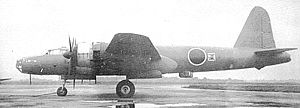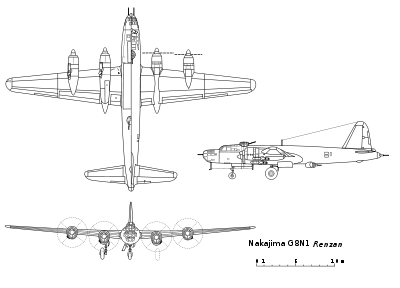- Nakajima G8N
-
G8N Renzan Role Heavy bomber Manufacturer Nakajima Aircraft Company First flight 23. October 1944 Retired 1945 Primary user IJN Air Service Produced 4 The Nakajima G8N Renzan (連山, "Mountain Range") was a four-engine long-range bomber designed for use by the Imperial Japanese Navy. The Navy designation was "Type 18 land-based attack aircraft" (一八試陸上攻撃機); the Allied code name was "Rita".
Contents
Design and development
In February 1943 the Imperial Navy staff asked Nakajima Aircraft Company to design a four-engined bomber, capable of meeting an earlier specification set for a long-range land-based attack plane. The final specification, issued on 14 September 1943, called for a plane with a maximum speed of 320 knots (370 mph; 590 km/h) able to carry a 4,000 kg (8,800 lb) bomb-load 2,000 nmi (3,700 km; 2,300 mi) or a reduced bomb-load 4,000 nmi (7,400 km; 4,600 mi).[1]
Nakajima's design featured a mid-mounted wing of small area and high aspect ratio, a tricycle landing gear and a large single-fin rudder. Power came from four 2,000 hp Nakajima NK9K-L "Homare" 24 radial engines with Hitachi 92 turbosuperchargers driving four-bladed propellers. The engines were cooled by counter-rotating fans positioned just inside the engine cowlings.[1] Defensive armament included power-operated nose, dorsal, ventral and tail turrets along with two free-swiveling machine guns at the beam positions.[2]
Operational history
The initial prototype was completed in October 1944 and delivered to the Navy for testing in January 1945, a mere one year after the Navy ordered development to start. Three further examples were completed by June 1945, with the third prototype being destroyed on the ground by US carrier aircraft.[2]
Other than minor problems with the turbosuperchargers, the Renzan performed satisfactorily and the Navy hoped to have a total of 16 prototypes and 48 production-version G8N1s assembled by September 1945. But the worsening war situation and a critical shortage of light aluminum alloys led to the project's cancellation in June.[2]
One proposed variant was the G8N2 Renzan-Kai Model 22, powered by four 2,200 hp Mitsubishi MK9A radial engines and modified to accept attachment of the air-launched Ohka Type 33 Special Attack Bomber.[2]
Just prior to Japan's surrender in August 1945 consideration was also briefly given to producing an all-steel version of the aircraft, to be designated G8N3 Renzan-Kai Model 23, but the cessation of hostilities precluded any further development.[2]
After the war, one prototype was taken to the United States[3][4] and scrapped after testing. None are in existence today.
Variants
- G8N1 : Four-engine heavy bomber. Production version.
- G8N2 : Modified to carry Ohka Type 33 Special Attack Bomber. Four Mitsubishi MK9A radial engines.
- G8N3 : All-steel airframe.
Operators
Specifications (G8N1)
Data from Japanese Aircraft of the Pacific War[2]
General characteristics
- Crew: ten
- Length: 22.94 m (75 ft 3 in)
- Wingspan: 32.54 m (106 ft 9 in)
- Height: 7.20 m (23 ft 7 in)
- Wing area: 112 m² (1,205 ft²)
- Empty weight: 17,400 kg (38,400 lb)
- Loaded weight: 26,800 kg (59,100 lb)
- Max takeoff weight: 32,150 kg (70,900 lb)
- Powerplant: 4 × Nakajima NK9K-L Homare 24 18-cylinder radial engines, 1,491 kW (2,000 hp) each
Performance
- Maximum speed: 576 km/h (358 mph)
- Range: 7,250 km (4,500 miles)
- Service ceiling: 10,200 m (33,500 ft)
- Rate of climb: 457 m/min (1,500 ft/min)
- Wing loading: 239 kg/m² (49 lb/ft²)
- Power/mass: 0.22 kW/kg (0.14 hp/lb)
Armament
- 2× 20 mm Type 99 cannon in each dorsal, ventral, and tail turrets
- 2× 13.2 mm (.51 in) Type 2 machine guns in nose turret
- 2× 13.2 mm (.51 in) Type 2 machine gun in fuselage sides
- Up to 4,000 kg (8,818 lb) of bombs
See also
- Aircraft of comparable role, configuration and era
References
- Notes
- ^ a b Francillon, p. 440.
- ^ a b c d e f Francillon 1979, p. 441.
- ^ Thorpe 1977, p. 27.
- ^ A G8N "Rita" in the USA via http://www.ww2incolor.com
- Bibliography
- Collier, Basil. Japanese Aircraft of World War II. New York: Mayflower Books, 1979. ISBN 0-8317-5137-1.
- Francillon, Ph.D., René J. Japanese Aircraft of the Pacific War. London: Putnam & Company Ltd., 2nd edition 1979. ISBN 0-370-30251-6.
- Thorpe, Donald W. Japanese Naval Air Force Camouflage and Markings World War II. Fallbrook, California: Aero Publishers, Inc., 1977. ISBN 0-8168-6583-3. (hc.) ISBN 0-8168-6587-6 (pbk.)
- Unknown authors. Famous Airplanes of the World: Nakajima Shinzan / Renzan (Volume 11, no.146). Japan: Bunrin-Do, Nov. 1984.
Aircraft produced by Nakajima Aircraft Company Imperial Japanese Navy types Imperial Japanese Army types World War II Allied reporting names Japanese Navy Land Based Bomber Designations World War II Allied reporting names for Japanese aircraft Aircraft in Japanese service Abdul • Alf • Ann • Babs • Baka • Belle • Betty • Bob • Buzzard • Cedar • Cherry • Clara • Claude • Cypress • Dave • Dick • Dinah • Dot • Edna • Emily • Eva • Eve • Frances • Frank • Gander • George • Glen • Goose • Grace • Gwen • Hamp • Hank • Hap • Helen • Hickory • Ida (Tachikawa Ki-36) • Ida (Tachikawa Ki-55) • Irving • Jack • Jake • Jane • Jean • Jerry • Jill • Jim • Judy • Kate • Kate 61 • Laura • Lily • Liz • Lorna • Loise • Louise • Luke • Mabel • Mary • Mavis • Myrt • Nate • Nell • Nick • Norm • Oak • Oscar • Pat • Patsy • Paul • Peggy • Perry • Pete • Pine • Rex • Rita • Rob • Rufe • Ruth • Sally • Sally III • Sam • Sandy • Slim • Sonia • Spruce • Stella • Steve • Susie • Tabby • Tess • Thalia • Thelma • Theresa • Thora • Tina • Tillie • Toby • Tojo • Tony • Topsy • Val • Willow • Zeke • Zeke 32
Nonexistent aircraft thought to be in Japanese service Adam • Ben • Doris • Gus • Harry • Ione • Joe • Joyce • Julia • June • Norma • Omar • Ray
Foreign aircraft erroneously thought to be in Japanese service Lists relating to aviation General Aircraft (manufacturers) · Aircraft engines (manufacturers) · Airlines (defunct) · Airports · Civil authorities · Museums · Registration prefixes · Rotorcraft (manufacturers) · TimelineMilitary Accidents/incidents Records Categories:- Japanese bomber aircraft 1940–1949
- World War II Japanese heavy bombers
- Abandoned military aircraft projects of Japan
- Nakajima aircraft
Wikimedia Foundation. 2010.


